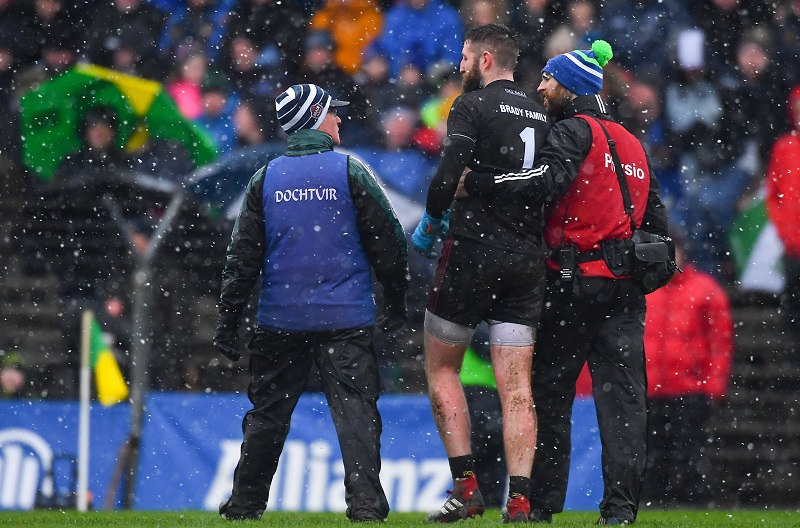By Patrick Morrison
WITHIN my 11 goalkeeping principles, number eight is named ‘recovery.’ This principle deals with two types of recovery within the abilities of a goalkeeper. The first aspect of goalkeeping recovery focuses on how quickly the goalkeeper can reset themselves back into their set position after having made a save, caught a high ball, fallen over, shifted their balance or any other reason that takes them away from their original set position.
The ‘set’ position of the goalkeeper being on the balls of the feet, body weight slightly forward bent at the waist, knees bent and legs shoulder width apart. The goalkeeper’s arms are held out to the sides slightly with the palms of their hands facing towards the ball. Like a coiled spring they are ready to pounce and from this position every action a goalkeeper needs to perform can be executed effectively.
The second part of the recovery principle concentrates on how well a goalkeeper can deal with or recover from any mistakes that have been made, goals that have been conceded, loss of their place or loss of form. This aspect has a major psychological input but ultimately affects the goalkeeper’s physiological outcomes.
Now that the GAA seasons have been condensed into two separate parts (county and club), there is another aspect of recovery that all players must focus upon. With so many competitions having to be completed over a shorter period of time and intensity of games and training sessions being heightened to achieve success, recovery off the field will be of the utmost importance.
For these shorter seasons and higher intensity games whether it be with the first or second team or maybe even third team, because of the shorter turnaround times between games and training you must put a concerted effort into ensuring that you recover well between games and training sessions.
First and foremost is making sure you are getting enough rest, especially quality sleep. Eight plus hours should be a mandatory part of your recovery program between sessions. There are professional teams that actually track their athlete’s sleep in a bid to try and predict performance or more importantly injury risks in a bid to prevent them before they even happen. Tracking your sleep is extremely easy and with the advancements in technology there are numerous smart watches or wearable devices that can record your sleeping patterns in great detail.
The next important aspect to focus on is your nutrition, which includes hydration. There is no need for a full in-depth scientific knowledge of nutrition but having a basic understanding of what you are putting into your body is vital. It is also very worthwhile to understand when the best times are for eating certain foods. By gaining this knowledge it will enable the goalkeeper to maximise their performance as much as possible. In regard to fluid intake, it is essential to know what your own personal hydration requirements are. There are general guidelines that players can follow but ultimately you must understand what works best for you and stick to it.
Introducing prehab activities before sessions and games has become a crucial part of any goalkeeper’s routine in order to reduce the risk of soft tissue injuries. It will be advisable to learn what are the muscles and groups of muscles that a goalkeeper uses most during the game as well as understanding correctly which muscles perform which goalkeeping actions. For example, the muscles a goalkeeper uses the most are located within their hips. From the hip flexor muscles to the deep lateral rotators to the core stability muscles these are the groups of muscles that feel stiff and painful the morning after training or a game so it would be wise to focus on activating these before training/games start.
Whenever muscles become worked, they become stiff and painful so the goalkeeper will need to work on trying to work these pains out before the next session or game. This can be done by booking appointments with trained professionals who are well versed in removing these aches and pains from tired, stiff muscles.
Another option is to work out these pains yourself using a foam roller or similar object. Rolling over the muscles in the direction the muscle fibres are flowing removes any lactate or other fluids not required to be present, therefore stopping the muscle fibres from calcifying further which increases injury risk.
If and when injuries do occur it is essential that you follow the advice of the medical professionals as well as the advice of any qualified team member (physio, doctor or therapist) to reduce the impact of the injury as much as possible.
Whenever they provide you with a rehab or recovery protocol then it is vital that it is followed to the letter as best as possible because these are designed to return you to play in the shortest time possible.
It is also important to note that as a goalkeeper’s body is recovering from an injury, the healing process requires massive amounts of energy to repair the injured tissues or structures. With this said, the goalkeeper will need to increase their calorie intake to help achieve the calories required to provide this energy requirement, not to mention that every injury is different so different types of minerals and nutrients will be required for optimal recovery.
With games coming thick and fast over the next few months, and with championship football literally only a few short weeks away, making sure you stay injury free will be the most important aspect of your training and match day goals. This is why your recovery between sessions and games will be of the utmost importance. If you want to produce optimal performance, then “Recovery Comes First!”
Email: pmgoalkeeping@hotmail.com
Facebook: @MSoG11
Twitter: @MorSchGk
Receive quality journalism wherever you are, on any device. Keep up to date from the comfort of your own home with a digital subscription.
Any time | Any place | Anywhere












